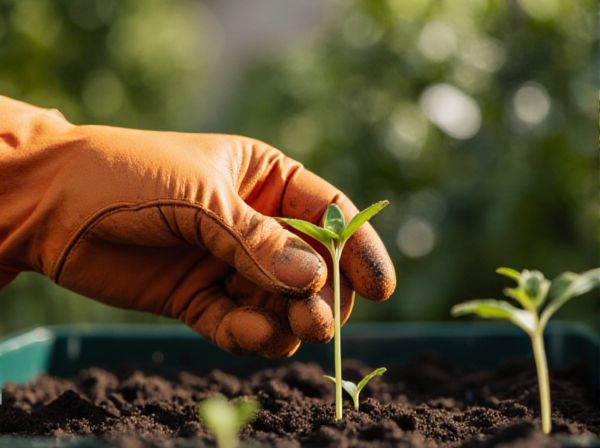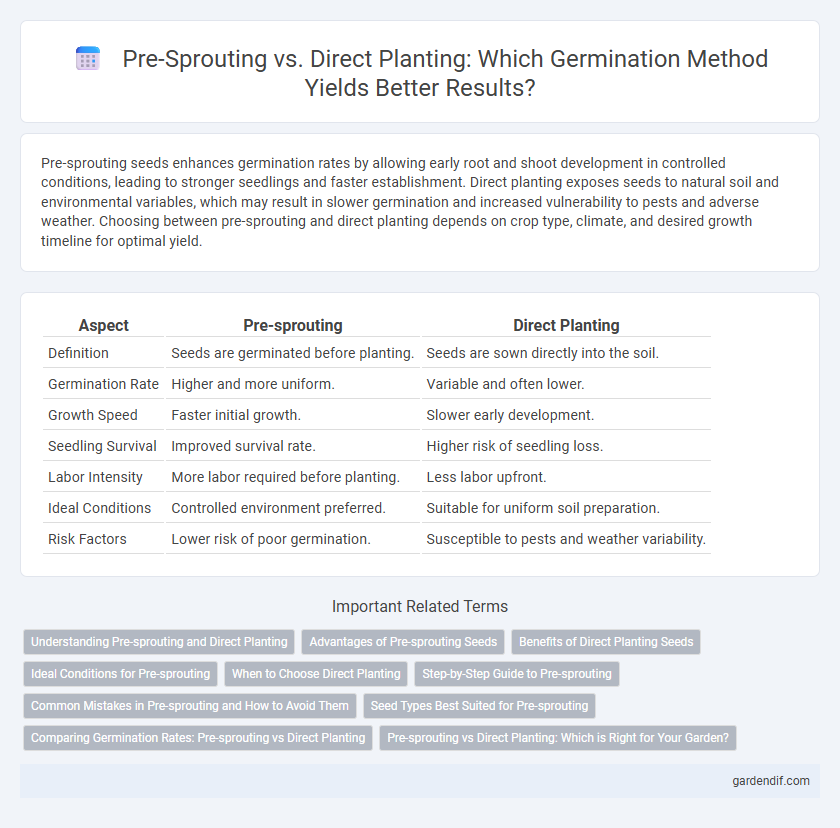
Pre-sprouting vs Direct Planting Illustration
Pre-sprouting seeds enhances germination rates by allowing early root and shoot development in controlled conditions, leading to stronger seedlings and faster establishment. Direct planting exposes seeds to natural soil and environmental variables, which may result in slower germination and increased vulnerability to pests and adverse weather. Choosing between pre-sprouting and direct planting depends on crop type, climate, and desired growth timeline for optimal yield.
Table of Comparison
| Aspect | Pre-sprouting | Direct Planting |
|---|---|---|
| Definition | Seeds are germinated before planting. | Seeds are sown directly into the soil. |
| Germination Rate | Higher and more uniform. | Variable and often lower. |
| Growth Speed | Faster initial growth. | Slower early development. |
| Seedling Survival | Improved survival rate. | Higher risk of seedling loss. |
| Labor Intensity | More labor required before planting. | Less labor upfront. |
| Ideal Conditions | Controlled environment preferred. | Suitable for uniform soil preparation. |
| Risk Factors | Lower risk of poor germination. | Susceptible to pests and weather variability. |
Understanding Pre-sprouting and Direct Planting
Pre-sprouting involves initiating seed germination under controlled conditions before transferring seedlings to soil, enhancing early growth and uniformity. Direct planting means sowing seeds directly into the field, relying on natural soil and environmental conditions for germination. Understanding these methods helps optimize crop establishment by balancing early development advantages with labor and environmental adaptability.
Advantages of Pre-sprouting Seeds
Pre-sprouting seeds accelerates germination by providing controlled moisture and temperature conditions, ensuring higher seedling vigor and uniform growth. This method reduces seed wastage by identifying viable seeds early, leading to improved crop establishment and higher yields. Pre-sprouting also allows for an earlier planting window, which can optimize growing seasons and enhance overall productivity.
Benefits of Direct Planting Seeds
Direct planting seeds allows for natural root development and stronger plant establishment by avoiding transplant shock, resulting in higher survival rates and improved crop yields. This method reduces labor costs and time since it bypasses the pre-sprouting stage, making it more efficient for large-scale farming. Soil microbes and mycorrhizal associations remain undisturbed, enhancing nutrient uptake and plant health throughout growth.
Ideal Conditions for Pre-sprouting
Pre-sprouting requires a controlled environment with consistent moisture levels between 70-90%, temperatures of 20-25degC, and indirect light to stimulate seed germination effectively. The use of sterile, well-draining mediums like vermiculite or peat moss minimizes fungal infections and promotes healthy seedling development. Maintaining high humidity and adequate ventilation in a germination chamber or tray enhances the success rate of pre-sprouting compared to direct planting.
When to Choose Direct Planting
Direct planting is ideal when soil temperature and moisture levels are consistently favorable for seed germination, ensuring rapid root establishment and reducing transplant shock risk. It suits crops with robust seedling vigor or those that do not tolerate root disturbance, such as root vegetables and beans. Choosing direct planting streamlines labor and resources by eliminating the need for transplanting, making it cost-effective for large-scale field production.
Step-by-Step Guide to Pre-sprouting
Pre-sprouting seeds involves soaking them in water for 12-24 hours to initiate germination, followed by placing them between damp paper towels or in a moist growing medium to maintain humidity. Monitor seeds daily, ensuring they remain moist until small roots or sprouts appear, usually within 3-7 days, signaling readiness for transplanting. This method enhances germination rates and reduces seedling mortality compared to direct planting by allowing early growth control and better root development.
Common Mistakes in Pre-sprouting and How to Avoid Them
Common mistakes in pre-sprouting include overwatering seeds, which leads to mold growth, and inconsistent temperature control that hinders uniform germination. To avoid these issues, maintain a consistently moist but not saturated environment and use a temperature-controlled space between 20-25degC (68-77degF). Selecting viable seeds and using breathable containers also improve oxygen flow, preventing rot and ensuring successful sprout development.
Seed Types Best Suited for Pre-sprouting
Seeds with hard coats or long dormancy periods, such as beans, peas, and certain tree seeds, are best suited for pre-sprouting to enhance germination rates and uniformity. Pre-sprouting accelerates seedling development by providing controlled moisture and temperature conditions, essential for seeds that require scarification or stratification. Small-seeded vegetables like lettuce or carrots are less commonly pre-sprouted due to their delicate roots and faster natural germination.
Comparing Germination Rates: Pre-sprouting vs Direct Planting
Pre-sprouting techniques consistently yield higher germination rates compared to direct planting, with success rates often exceeding 85% versus 60-70% in direct sowing. By enabling early seedling development under controlled conditions, pre-sprouting reduces seedling mortality and improves uniformity in crop establishment. Direct planting, while less labor-intensive, faces greater variability due to soil moisture, temperature fluctuations, and pest exposure impacting germination success.
Pre-sprouting vs Direct Planting: Which is Right for Your Garden?
Pre-sprouting seeds accelerates germination by allowing early root and shoot development, reducing transplant shock and improving seedling survival rates. Direct planting simplifies the process and minimizes labor but risks uneven germination and vulnerability to environmental factors like pests and weather. Choosing between pre-sprouting and direct planting depends on your garden's climate, soil conditions, and desired crop timeline for optimal growth.
Pre-sprouting vs Direct Planting Infographic

 gardendif.com
gardendif.com